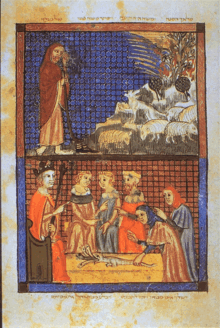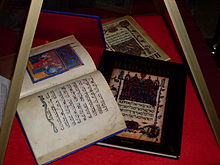- Sarajevo Haggadah
-
The Sarajevo Haggadah is an illuminated manuscript that contains the illustrated traditional text of the Passover Haggadah which accompanies the Passover Seder. It is one of the oldest Sephardic Haggadahs in the world, originating in Barcelona around 1350. The Haggadah is presently owned by the National Museum of Bosnia and Herzegovina in Sarajevo, where it is on permanent display. Its monetary value is undetermined, but a museum in Spain required that it be insured for $7 million before it could be transported to an exhibition there in 1992.[1]
The Sarajevo Haggadah is handwritten on bleached calfskin and illuminated in copper and gold. It opens with 34 pages of illustrations of key scenes in the Bible from creation through the death of Moses. Its pages are stained with wine, evidence that it was used at many Passover Seders.[2]
History
 An illustrated page from the Sarajevo Haggadah, written in fourteenth-century Spain. Top: Moses and the Burning Bush. Bottom: Aaron's staff swallows the magicians'
An illustrated page from the Sarajevo Haggadah, written in fourteenth-century Spain. Top: Moses and the Burning Bush. Bottom: Aaron's staff swallows the magicians'
The Sarajevo Haggadah has survived many close calls with destruction. Historians believe that it was taken out of Spain by Spanish Jews who were expelled by the Alhambra Decree in 1492. Notes in the margins of the Haggadah indicate that it surfaced in Italy in the 16th century. It was sold to the National Museum in Sarajevo in 1894 by a man named Joseph Kohen.[3]
During World War II, the manuscript was hidden from the Nazis and Ustashe by the Museum's chief librarian, Derviš Korkut, who at risk to his own life, smuggled the Haggadah out of Sarajevo. Korkut gave it to a Muslim cleric in Zenica, where it was hidden under the floorboards of either a mosque or a Muslim home. In 1957, a facsimile of the Haggadah was published by Sándor Scheiber, director of the Rabbinical Seminary in Budapest. In 1992 during the Bosnian War, the Haggadah manuscript survived a museum break-in and it was discovered on the floor during the police investigation by a local Inspector (Detective), Fahrudin Čebo (later nicknamed (Haggadah), with many other items thieves believed were not valuable. It later survived in an underground bank vault when Sarajevo was under constant siege by Bosnian Serb forces (Siege of Sarajevo – the longest siege in the history of modern warfare). To quell rumors that the government had sold the Haggadah in order to buy weapons, the president of Bosnia presented the manuscript at a community Seder in 1995.
Afterwards, the manuscript was restored through a special campaign financed by the United Nations and the Bosnian Jewish community in 2001, and went on permanent display at the museum in December 2002.
In 1985 a reproduction was printed in Ljubljana, 5,000 copies were made. More recently, the museum has authorized the publication of a limited number of reproductions of the Sarajevo Haggadah, each of which has become a collector's item. In May 2006, the Sarajevo publishing house Rabic Ltd., announced the forthcoming publication of 613 copies of the Haggadah on handmade parchment that attempts to recreate the original appearance of the 14th century original, alluding to the 613 Mitzvot.[4]
There is a brief mention of the manuscript in the motion picture, "Welcome to Sarajevo". The novel People of the Book, by Geraldine Brooks (2008), crafts a fictionalised and highly imaginative history of the Haggadah from its origins in Spain to the museum in Sarajevo. The Winter, 2002, issue of the literary journal Brick published Ramona Koval's account of the disputes surrounding the proposed UNESCO-funded display of the original codex in the context of the post-Dayton Agreement UN-supervised 1995 peace settlement.
The history of Derviš Korkut, who saved the book from the Nazis, was told in an article by Geraldine Brooks in The New Yorker magazine.[3] The article also sets out the story of the young Jewish girl, Mira Papo, whom Korkut and his wife hid from the Nazis as they were acting to save the Haggadah. In a twist of fate, as an elderly woman in Israel, Mira Papo secured the safety of Korkut's daughter during the Bosnian war in the 1990s.
References
- ^ http://haggadah.ba/?x=1
- ^ http://www.sdjewishjournal.com/stories/apr06_4.html[dead link]
- ^ a b http://geraldinebrooks.com/wp-content/uploads/0207/12/Korkut_near-final-pages.pdf The Book of Exodus, an article by Geraldine Brooks in The New Yorker
- ^ http://haggadah.ba/?x=4
External links
Passover • פֶּסַח Seder Haggadah Illustrations- Sarajevo Haggadah
- Szyk Hagaddah
Passover foods Matzah productsMatzah companiesReligious ObservancesLaws/CustomsPrayers- Song of Songs
- Torah readings
- Prayer for dew
Categories:- 14th-century illuminated manuscripts
- Culture in Barcelona
- Culture in Sarajevo
- Haggadah of Pesach
- History of Sarajevo
- Jewish illuminated manuscripts
- Jewish prayer and ritual texts
- Judaism in Bosnia and Herzegovina
Wikimedia Foundation. 2010.

